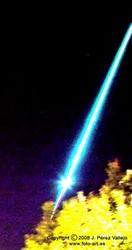- The Bejar bolide photographed from Torrelodones, Madrid, Spain. The incoming fireball is the streak to the right of the floodlit house. The bright light at the top is the overexposed Moon. Credit: J. Perez Vallejo/SPMN.
Astronomers have analyzed the cometary fireball that blazed across the sky over Europe last year and concluded it was a dense object, about a meter (3.2 feet) across and with a mass of nearly two tons — large enough that some fragments probably survived intact and fell to the ground as meteorites.
Last July, people in Spain, Portugal and France watched the brilliant fireball produced by a boulder crashing down through the Earth’s atmosphere. In a paper to be published in the journal Monthly Notices of the Royal Astronomical Society, astronomer Josep M. Trigo-Rodríguez, of the Institute of Space Sciences in Spain, and his co-authors present dramatic images of the event. The scientists also explain how the boulder may originate from a comet which broke up nearly 90 years ago, and suggest that chunks of the boulder (and hence pieces of the comet) are waiting to be found on the ground.
“If we are right, then by monitoring future encounters with other clouds of cometary debris, we have the chance to recover meteorites from specific comets and analyse them in a lab,” Dr Trigo-Rodríguez said. “Handling pieces of comet would fulfil the long-held ambitions of scientists — it would effectively give us a look inside some of the most enigmatic objects in the Solar System.”
Fireballs (or bolides) are the name given by astronomers to the brightest meteors, popularly referred to as shooting stars. On the afternoon of July 11, a brilliant fireball was recorded over southwestern Europe. At maximum intensity, the object was more than 150 times brighter than the full Moon. It was first picked up at a height of 61 miles (98.3 km) and disappeared from view 13 miles (21.5 km) above the surface of the Earth, tracked by three stations of the Spanish Fireball Network above Bejar, near Salamanca in Spain. At the same time, a professional photographer took a picture of the fireball from the north of Madrid.

From these images, the astronomers have demonstrated that before its fiery demise, the boulder traveled on an unusual orbit around the Sun, which took it from beyond the orbit of Jupiter to the vicinity of Earth. This orbit is very similar to that of a cloud of meteoroids known as the Omicron Draconids, which on rare occasions produces a minor meteor shower and probably originates from the breakup of Comet C/1919 Q2 Metcalf in 1920. The authors suggest the boulder was once embedded in the nucleus of that comet.
Comet C/1919 Q2 Metcalf was discovered by Joel Metcalf from Vermont in August 1919, and was visible until February 3, 1920. The orbit was not well determined and no subsequent appearances are known. The Omicron Draconids meteor stream was discovered to be following a similar orbit to this comet by Allan F. Cook in 1973. The stream characteristically produces bright fireballs and rare meteor outbursts.
In the mid-1980s, the astronomers Tamas I. Gombosi and Harry L.F. Houpis first suggested that the nuclei of comets consist of relatively large boulders cemented together by a ‘glue’ of smaller particles and ice. If the rocky and icy nucleus of a comet disintegrates, then these large boulders are set loose into space. If the Bejar bolide was formed in this way, it confirms the glue model for at least some comets.
Source: Royal Astronomical Society


Wow, magnitude > -17 brillance! It was many years ago I saw a Bolide about -16, some seconds later I heard a sound more liken to a deep reverberation lasting a 8-10 seconds the likes of which I couldn’t comprehend–I was living in the Portland,Ore area at that time, many heard the sound and a many saw the Bolide, but there was no indication it hit the Earth anywhere-the sound was the
thing that really amazed me!!! No thunder sound I know of could’ve done that!
I experienced a sonic boom from an early evening bolide event over North Central Iowa about a year and a half ago. The boom was enough to rattle my house. There were eyewitness who saw the bolide that evening (about 2-1/2 hours before sunset). The next day in the mid-afternoon, there was another bolide event about 60 miles north of my location, with plenty of eyewitnesses and also being captured on video.
The end times are neigh.